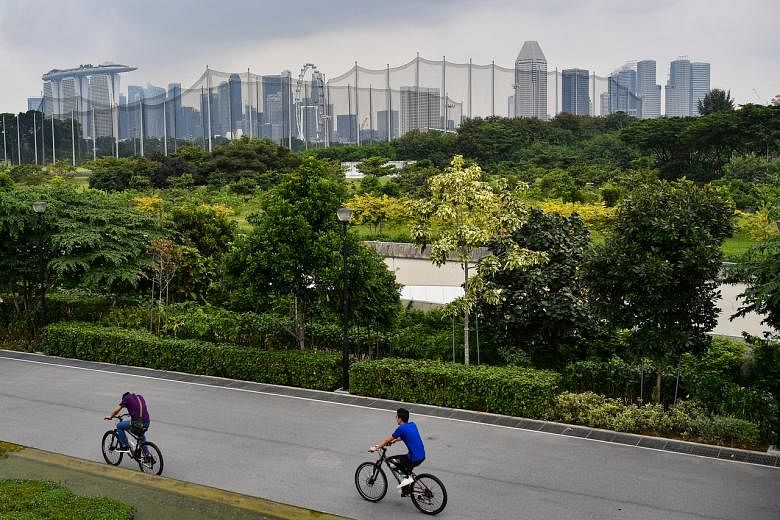SINGAPORE - For the first time in 50 years, the review of Singapore's long-term land use plans will yield not just one plan, but several options to deal with an increasingly uncertain future, and Singaporeans are being asked to contribute their ideas and vision.
As part of the review, the public's opinions are being sought through a year-long consultation exercise, the Urban Redevelopment Authority (URA) announced on Saturday (July 17).
Amid greater uncertainties caused by social, demographic, environmental and technological changes, flexibility is one key focus of the long-term planning review as it will allow future generations to adapt and adjust to disruptions such as Covid-19, URA said.
At a launch event for the public consultation on Saturday, National Development Minister Desmond Lee touched on how land use can be affected by a pandemic.
He said: "Learning from this pandemic, do we need to set aside buffers in our land use plans that we can quickly convert and pivot for contingency uses?... Do we need to set aside more space to produce goods and services, or even food, that meet our own needs, so that we need not be so reliant on imports from abroad during a crisis, even as we diversify?"
Mr Lee added: "We must not only plan for what we know now, but also prepare for what we might not know about."
He said trends such as the rise of e-commerce and an ageing population will change how Singapore plans for its future.
Asked to give examples of the future possibilities that planners are preparing for, URA's chief planner Hwang Yu-Ning said: "I think this (review) is the process of trying to understand what the possibilities are.
"I don't think we are in a place to name it yet, because we want to hear from the community... and then from there be able to develop a set of options."
Citing the Central Business District (CBD), she said two general approaches could be taken - sustaining and growing it, or having it spread across multiple sites.
And if a decision was made to shrink the size of the current CBD, she said, the authorities would then have to look at how to use land that was previously zoned for office space, or how to create more residential opportunities in the current business district.
Reviewing the country's land-use needs has taken place since 1971, with each review culminating in a single concept plan, to guide the nation's urban planning for the next 40 to 50 years. From 1991, reviews were conducted every decade, and the last concept plan was out in 2011.
Even as this long-term planning review is under way, whether it will produce a broad plan comprising several options, or a few different plans, remains to be seen, with URA keeping its options open.
Experts told The Straits Times that the move to make plans flexible is necessary and timely, given current world developments.
DP Architects chief executive Seah Chee Huang said Singaporeans today are in the midst of a perfect storm, with major shifts and disruptions due to industrialisation, digitalisation, decarbonisation and a heightened awareness of the importance of health and well-being, due to the pandemic.
Such challenges, he said, necessitate a more inclusive approach to planning, and should involve everyday Singaporeans.
"Public engagement acts as a catalyst for more ground-up responses and participation, and empowers the community, fostering a stronger sense of ownership," said Mr Seah.
Ms Nina Yang, the chief executive of SJ CityGlobal, a development consultancy under Surbana Jurong, said the Covid-19 pandemic has shown the importance of flexibility and resiliency in how cities are planned.
"Before the pandemic, we already knew that a data revolution was under way. But Covid-19 came along and hastened the adoption of technology in every aspect of our lives, especially in how we work and operate our businesses," said the vice-president of the Singapore Institute of Planners.
"Preparing for different scenarios will help Singapore adapt more proactively to such disruptions."
She added that a creative and vibrant cityscape is one of the key attributes to keeping Singapore attractive to investment and talent as an international hub, amid rising competition from other Asian cities.

But heritage conservation expert Johannes Widodo said that apart from economic viability, plans had to ensure cultural authenticity, environmental sustainability, historical continuity and social inclusivity.
To this end, he said, he was encouraged by the inclusion of youth in planning discussions.
Associate Professor Widodo, from the National University of Singapore, suggested that to engage younger participants, the URA could work with schools and civic groups to make discussions more inclusive for the young.
"The right of future space belongs to the present-day youth," he said.
Asked about URA's intention to cater to various possibilities, Dr Shawn Lum, a botanist at Nanyang Technological University, said he was certain that a lower ecological footprint, abundant greenery and thriving nature will be a common feature of any envisioning of Singapore's future, as the pandemic has highlighted the importance of nature to people's physical and emotional well-being.
He added that the efficient use of space, consolidating transport infrastructure and decreasing dependence on private cars, and nature-friendly features in the built environment could help meet development needs and increase nature here.
Dr Lum, who is president of Nature Society (Singapore), added that rather than thinking of land use in terms of competing priorities, which will always exist, it may be more productive to think of integrated uses, such as having housing and green areas within the same space.
Public consultation for the long-term planning review will take place in four phases between this month and next June, with each phase lasting about three months.
The first phase, which began on Saturday, seeks to canvass broader hopes and aspirations of Singaporeans through online polls and workshops. Subsequent phases will build on inputs from the first.
Various segments of the population, such as businesses, planning professionals and those in academic circles, will also be involved from the second phase.
Mr Lee and Second Minister for National Development Indranee Rajah kick-started the consultation on Saturday, in a closed-door discussion with 20 young people.
One participant, Mr Eric Teo, said several youth at the discussion expressed their wish to age actively and build stronger relationships.
The 23-year-old, who will enrol in university next month, said he shared these desires as he felt society has become increasingly colder, with people more isolated and spending more time online.
He called for a return of the kampung spirit, suggesting that communal spaces such as void decks be modernised to encourage young people to invest in relationships offline.
The public can provide their views through an online poll at this website until Aug 16.
Details on how to participate in subsequent phases of the review will be made known at a later date.


